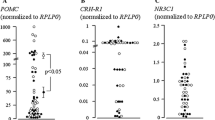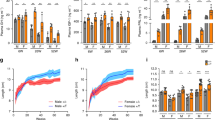Abstract
Abnormal GH responses to GnRH test, observed in about 15% of patients with acromegaly, have been reported exclusively in patients bearing tumors without gsp mutation. The absence of responsiveness to GnRH in gsp+ tumors was not predicted on the basis of the mechanism of GnRH action that mainly involves the activation of calcium and protein kinase C dependent pathways. The aim of the present study was to investigate in detail the transduction of GnRH signaling in these tumors. GH-secreting adenomas removed from patients in vivo responsive to GnRH test were studied. Tumor DNA was screened for Gsa and GnRH receptor gene sequences. Intracellular calcium ([Ca2+]i) and cAMP levels were measured in dispersed cells and adenylyl cyclase (AC) activity in membrane preparations. DNA analysis showed wild sequence of both Gsα and GnRH receptor genes. GnRH caused a significant increase in intra-cellular Ca2+ that was associated with a significant stimulation of cAMP accumulation. In these cells neither TRH nor GHRP-6 were effective in causing significant modifications of cAMP levels, despite their ability to increase [Ca2+]i. Finally, GnRH was able to directly stimulate AC from 11.1±3.3 pmol/mg prot/min to 26.9±5.4 (p<0.005). We report that GnRH was effective in increasing both [Ca2+]i and AC in GH-secreting adenomas removed from responsive patients. The ability of GnRH to signal through Gsα protein may account for the lack of GH responses to GnRH observed in acromegalic patients with tumors carrying gsp mutation.
Similar content being viewed by others
References
Faglia G. Genesis of pituitary adenomas. In: Landolt AM, Vance ML, Reilly PL eds. Pituitary adenomas. New York: Churchill Livingstone. 1996, 3–13.
Arosio M, Giovanelli M, Riva E, Nava C, Ambrosi B, Faglia G. Clinical use of pre- and postsurgical evaluation of abnormal GH response in acromegaly. J Neurosurg 1983, 59: 402–8.
Spada A, Arosio M, Bochicchio D, et al. Clinical, biochemical, and morphological correlates in patients bearing growth hormone-secreting pituitary tumors with or without constitutively active adenylyl cyclase. J Clin Endocrinol Metab 1990, 71: 1421–6.
Adams EF, Brockmeier S, Friedmann E, Roth M, Buchfelder M, Fahlbusch R. Clinical and biochemical characteristics of acromegalic patients harboring gsp-positive and gsp-negative pituitary tumors. Neurosurgery 1993, 33: 198–200.
Faglia G, Arosio M, Spada A. Gs protein mutations and pituitary tumors: functional correlates and possible therapeutic implications. Metabolism 1996, 45: 117–9.
Kaiser UB, Conn PM, Chin WW. Studies of gonadotropin-releasing hormone (GnRH) action using GnRH receptor-expressing pituitary cell lines. Endocr Rev 1997, 18: 46–70.
Ando H, Hew CL, Urano A Signal transduction pathways and transcription factors involved in the gonadotropin-releasing hormone-stimulated gonadotropin subunit gene expression. Comp Biochem Physiol B Biochem Mol Biol 2001, 129: 525–32.
Hsieh KP, Martin TFJ. Thyrotropin-releasing hormone and gonadotropin-releasing hormone receptors activate phos-pholipase C by coupling to the guanosine triphosphate-binding proteins Gq and G11. Mol Endocrinol 1992, 6: 1673–81.
Grosse R, Schmid A, Schoneberg T, et al. Gonadotropin-releasing hormone receptor initiates multiple signaling pathways by exclusively coupling to G(q/11) proteins. J Biol Chem 2000, 275: 9193–200.
Stanislaus D, Pinter JH, Janovick JA, Conn PM. Mechanisms mediating multiple physiological responses to gonadotropin-releasing hormone. Mol Cell Endocrinol 1998, 144: 1–10.
Han XB, Conn PM. The role of protein kinases A and C pathways in the regulation of mitogen-activated protein kinase activation in response to gonadotropin-releasing hormone receptor activation. Endocrinology 1999, 140: 2241–51.
Stanislaus D, Janovick JA, Jennes L, Kaiser UB, Chin WW, Conn PM. Functional and morphological chracterization of four cell lines derived from GH3 cells stably trnsfected with gonadotropin-relwasing hormone receptor complementary deoxyribonucleic acid. Endocrinology 1994, 135: 2220–7.
Liu F, Usui I, Evans LG, et al. Involvement of both Gq/11 and Gs proteins in gonadotropin-releasing hormone receptor-mediated signalling in LβT2 cells. J Biol Chem 2002, 277: 32099–108.
Bassetti M, Spada A, Arosio M, Vallar L, Brina M, Giannattasio G. Morphological studies on mixed growth hormone (GH)- and prolactn (PRL) secretine human pituitari adenomas. Coexistence of GH and PL in the same secretory granule. J Clin Endocrinol Metab 1986, 62: 1093–100.
Ballare E, Mantovani S, Lania A, Di Blasio AM, Vallar L, Spada A. Activating mutations of the Gs alpha gene are associated with low levels of Gs alpha protein in growth hormone-secreting tumors. J Clin Endocrinol Metab 1998, 83: 4386–90.
Spada A, Reza-Elahi F, Lania A, Gil-del-Alamo P, Bassetti M, Faglia G. Hypothalamic peptides modulate cytosolic free Ca2+ levels and adenylyl cyclase activity in human nonfunctioning pituitary adenomas. J Clin Endocrinol Metab 1991, 73: 913–8.
Lania A, Persani L, Ballare E, Mantovani S, Losa M, Spada A. Constitutively active Gs alpha is associated with an increased phosphodiesterase activity in human growth hormone-secreting adenomas. J Clin Endocrinol Metab 1998, 83: 1624–8.
Vallar L, Spada A, Giannattasio G. Altered Gs and adenylate cyclase activity in human GH-secreting pituitary adenomas. Nature 1987, 330: 566–7.
Lania A, Ballare E, Corbetta S, Filopanti M, Persani L, Spada A. Growth hormone-releasing hexapeptide (GHRP-6) increases intracellular calcium concentrations in cultured cells from human pituitary adenomas of different types. Eur J Endocrinol 1998, 139: 343–8.
Insel PA, Ostrom RS. Forskolin as a tool for examining ade-nylyl cyclase expression, regulation, and G protein signaling. Cell Mol Neurobiol 2003, 23: 305–14.
Giannattasio G, Bianchi R, Spada A, Vallar L. Effect of calcium on adenylate cyclase of rat anterior pituitary gland. Endocrinology 1987, 120: 2611–9.
Kaye PV, Hapgood J, Millar PR. Absence of mutationsin exon 3 of the GnRH receptor in human gonadotroph adenomas. Clin Endocrinol (Oxf) 1997, 47: 546–54.
Wang WJ, Gilman AG. Type specific regulation of adenylyl cyclase by G protein bg subunits. Science 1991, 254: 1500–3.
Ford CE, Skiba NP, Bae H, Daaka Y, Reuveny E, Shekter LR. Molecular basis for interactions of G protein betagamma subunits with effectors. Science 1998, 280: 1271–4.
Dhanasekaran N, Tsim ST, Dermott JM, Onesime D. Regulation of cell proliferation by G proteins. Oncogene 1998, 17: 1383–94.
Naor Z, Benard O, Seger R. Activation of MAPK cascades by G-protein-coupled receptors: the case of gonadotropin-re-leasing hormone receptor. Trends Endocrinol Metab 2000, 11: 91–9.
Lania A, Filopanti M, Corbetta S, et al. Effects of hypothalamic neuropeptides on extracellular signal-regulated kinase (ERK1 and ERK2) cascade in human tumoral pituitary cells. J Clin Endocrinol Metab 2003, 88: 1692–6.
Lania A, Mantovani G, Spada A. G protein mutations in endocrine diseases. Eur J Endocrinol 2001, 145: 543–59.
Author information
Authors and Affiliations
Corresponding author
Rights and permissions
About this article
Cite this article
Lania, A., Mantovani, G., Ferrante, E. et al. Gonadotropin-releasing hormone initiates multiple signaling pathways in human GH-secreting adenomas. J Endocrinol Invest 27, 328–333 (2004). https://doi.org/10.1007/BF03351057
Accepted:
Published:
Issue Date:
DOI: https://doi.org/10.1007/BF03351057




